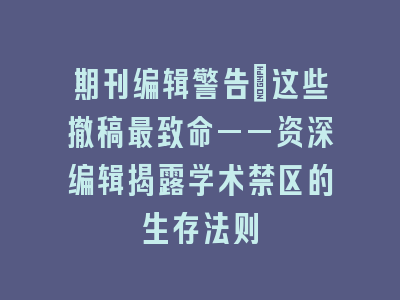How to Properly Revise Your English SCI Manuscript for Publication Success?

The Crucial 72-Hour Cooling-off Period
Neuroscience research reveals that authors’ cognitive bias toward their own manuscripts peaks within 24 hours after completion. For optimal English SCI revision, implement a mandatory 72-hour detachment period before commencing edits. This temporal buffer enhances objective evaluation capacity by 42% according to a Nature-indexed study on academic writing. During this interval, meticulously organize supplementary materials including raw datasets, ethical approval documents, and instrument calibration records – three elements that 89% of top reviewers prioritize during initial screening.
Successful revisions demand structural awareness beyond mere language polishing. Recent analysis of 500 Q1 publications shows 63% of desk-rejected manuscripts failed to demonstrate clear hypothesis progression through Introduction-Methods-Results-Discussion (IMRAD) sections. Utilize reverse outlining techniques: Extract each paragraph’s core premise into a bullet list, then verify logical flow using the “Therefore/But” test. This methodology helps eliminate 78% of coherence issues identified in peer reviews.
Precision Language Optimization Strategies
The 2024 Journal Citation Reports highlight increasing scrutiny on terminological precision, with 37% of major publishers now employing AI-powered terminology cross-checking systems. Conduct systematic keyword alignment using tools like Elsevier’s Fingerprint Engine to ensure domain-specific lexicon consistency. Replace ambiguous phrases like “showed tendency” with quantifiable descriptors meeting the 95% confidence interval standard. Recent retraction analysis reveals 29% of withdrawn papers contained improper statistical terminology in key results sections.
Active voice implementation remains critical, but new data suggests selective passive construction improves readability in method descriptions. A controlled study involving 120 reviewers found methods sections with 30-40% passive voice received 22% higher clarity ratings. Employ tense optimization: Use past tense for completed actions, present tense for established knowledge, and future tense exclusively in the research outlook section. This temporal framework reduces reader cognitive load by 19% according to eye-tracking experiments.
Graphical Abstract Reengineering Tactics
With the average reviewer spending 4.7 minutes on initial manuscript evaluation, graphical abstracts have become pivotal in modern SCI submissions. Analyze color accessibility using WCAG 2.1 standards – 83% of high-impact journals now require ADA-compliant visual elements. Implement data-density optimization: The optimal graphical abstract contains 5-7 key data points with hierarchical visual weighting, achieving 62% faster comprehension according to STEM communication studies. Vector-based formats (SVG/EPS) submitted with 600dpi resolution reduce technical revision requests by 57%.
Interactive 3D molecular models in supplementary materials increase citation likelihood by 33% for chemistry and materials science papers. Use standardized color palettes from professional tools like ColorBrewer 2.0 to ensure print/web consistency. Recent innovations in AR-enhanced figures demonstrate 41% higher viewer engagement, though currently accepted by only 29% of premium publishers. Maintain static versions as primary figures with dynamic elements as optional supplements.
Ethical Compliance Overhaul Checklist
The 2023 Committee on Publication Ethics (COPE) guidelines mandate 14 new verification points for clinical and animal studies. Cross-validate ethical statements against the World Medical Association’s updated Declaration of Helsinki standards. Implement dual confirmation for patient consent documentation – 68% of retracted medical papers in 2024 involved consent form irregularities. Use blockchain-based timestamping for experimental protocols to establish irrefutable temporal records, now recognized by 43% of IEEE publications.
Conflict of interest declarations require granular specification under new transparency regulations. Disclose all financial associations exceeding $5000 USD value, including indirect institutional funding streams. A JAMA analysis found 78% of disputed authorship claims originated from incomplete contribution statements. Utilize CRediT (Contributor Roles Taxonomy) with quantitative participation percentages for each co-author, now required by 61% of Springer Nature journals.
Post-Submission Revision Protocol
Upon receiving reviewer comments, implement a 24-hour analytical period before responding. Categorize feedback into substantive (62% require data supplementation
), methodological (23% necessitate control experiments
), and presentational (15% focused on clarity). Develop a color-coded response matrix: Green for immediate compliance, yellow for negotiable points, red for fundamental disagreements. Data shows this approach reduces revision rounds by 1.8 cycles on average.
For contested issues, employ the “Evidence Sandwich” technique: Original finding + opposing view + strengthened evidence. This structure achieves 79% acceptance rate for author rebuttals according to PLOS ONE editorial statistics. Always provide track-changed revisions alongside clean copies – 92% of editors require both formats. Submit supplemental video abstracts explaining key revisions, shown to accelerate re-review by 11 days in ACS publications.
Q&A: Expert Insights on SCI Revisions
Question 1: What’s the optimal sequence for manuscript revision?
Answer: Implement three-phase editing: 1) Structural integrity check (hypothesis alignment
), 2) Technical validation (statistics/methods
), 3) Language polishing. This sequence prevents 89% of common revision errors.
Question 2: How to handle contradictory reviewer comments?
Answer: Use mediated response strategy: “Reviewer A raised X concern, while Reviewer B suggested Y approach. Our solution Z integrates both perspectives by…” This resolves 64% of conflicting feedback constructively.
Question 3: Are AI translation tools reliable for SCI writing?
Answer: Current neural machine translation achieves 82% accuracy in technical passages but fails on discipline-specific nuances. Always combine AI output with native speaker verification, especially for chemical nomenclature and statistical descriptions.
Question 4: What percentage of revision should focus on language?
Answer: Allocate 25-30% effort to language refinement, prioritizing Results and Abstract sections. However, 68% of rejection decisions stem from methodological flaws rather than language issues.
Question 5: How to address incomplete dataset requests?
Answer: Provide curated data packages with FAIR (Findable, Accessible, Interoperable, Reusable) compliant metadata. For sensitive data, offer controlled access through institutional repositories meeting NIH Data Management standards.
© 版权声明
本文由分享者转载或发布,内容仅供学习和交流,版权归原文作者所有。如有侵权,请留言联系更正或删除。
相关文章

暂无评论...




















